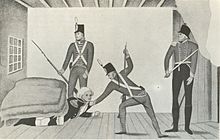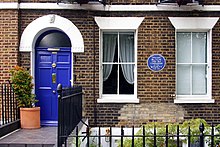User:Luqamatra/sandbox
Subsequent career and the Rum Rebellion[edit]
In February 1797, while Bligh was captain of HMS Director, he surveyed the River Humber, preparing a map of the stretch from Spurn to the west of Sunk Island.
In April-May, Bligh was one of the captains whose crews mutinied over "issues of pay and involuntary service for common seamen" during the Spithead mutiny.[1] Despite receiving some of their demands at Spithead, disputes over navy life continued among the common sailors. Bligh was again one of the captains affected during the mutiny at the Royal Navy anchorage of Nore. "Bligh became more directly involved in the Nore Mutiny", which "failed to achieve its goals of a fairer division of prize money and an end to brutality."[1] It should be noted that these events were not triggered by any specific actions by Bligh as they "were widespread, [and] involved a fair number of English ships".[1] It was at this time that he learned "that his common nickname among men in the fleet was 'that Bounty bastard'."[1]
As captain of Director at the Battle of Camperdown on 11 October, Bligh engaged three Dutch vessels: the Haarlem, the Alkmaar and the Vrijheid. While the Dutch suffered serious casualties, only seven seamen were wounded in Director. Director captured the Vrijehid and the Dutch commander Vice-Admiral Jan de Winter.
Bligh went on to serve under Admiral Nelson at the Battle of Copenhagen on 2 April 1801, in command of Glatton, a 56-gun ship of the line, which was experimentally fitted exclusively with carronades. After the battle, Nelson personally praised Bligh for Bligh's contribution to the victory. He sailed Glatton safely between the banks while three other vessels ran aground. When Nelson pretended not to notice Admiral Parker's signal "43" (stop the battle) and kept the signal "16" hoisted to continue the engagement, Bligh was the only captain in the squadron who could see that the two signals were in conflict. By choosing to fly Nelson's signal, he ensured that all the vessels behind him kept fighting.

Bligh had gained the reputation of being a firm disciplinarian. Accordingly, he was offered the position of Governor of New South Wales on the recommendation of Sir Joseph Banks (President of the Royal Society and a main sponsor of the breadfruit expeditions) and appointed in March 1805, at £2,000 per annum, twice the pay of the retiring Governor Philip Gidley King. He arrived in Sydney on 6 August 1806,[2] to become the fourth governor.[3] During his time in Sydney, his confrontational administrative style provoked the wrath of a number of influential settlers and officials. They included the wealthy landowner and businessman John Macarthur and prominent Crown representatives such as the colony's principal surgeon, Thomas Jamison, and senior officers of the New South Wales Corps. Jamison and his military associates were defying government regulations by engaging in private trading ventures for profit: Bligh was determined to put a stop to this practice.
The conflict between Bligh and the entrenched colonists culminated in another mutiny, the Rum Rebellion,[4] when, on 26 January 1808, 400 soldiers of the New South Wales Corps under the command of Major George Johnston marched on Government House in Sydney to arrest Bligh. A petition written by John Macarthur and addressed to George Johnston was written the day of the arrest but most of the 151 signatures were gathered in the days after Bligh's overthrow.
The present alarming state of this Colony, in which every mans property Liberty and Life is endangered induces us most earnestly to implore you instantly to place Governor Bligh under arrest and to assume the command of the Colony. -- We pledge Ourselves at a moment of less agitation to come forward to support the measure with our fortunes and our lives. A rebel government was subsequently installed and Bligh, now deposed, made for Hobart in Tasmania aboard HMS Porpoise. Bligh failed to gain support from the authorities in Hobart to retake control of New South Wales, and remained effectively imprisoned on the Porpoise from 1808 until January 1810.
Shortly after Bligh’s arrest, a watercolour illustrating the arrest by an unknown artist was exhibited in Sydney at perhaps Australia’s first public art exhibition.[5] The watercolour depicts a soldier dragging Bligh from underneath one of the servants’ beds in Government House and with two other figures standing by. The two soldiers in the watercolour are most likely John Sutherland and Michael Marlborough and the other figure on the far right is believed to represent Lieutenant William Minchin.[5] This cartoon is Australia’s earliest surviving political cartoon and like all political cartoons it makes use of caricature and exaggeration to convey its message.[6] The New South Wales Corps officers’ regarded themselves as gentlemen and in depicting Bligh as a coward, the cartoon declares that Bligh was not a gentleman and therefore not fit to govern.[6]
Of interest, however, was Bligh's concern for the more recently arrived settlers in the colony, who did not have the wealth and influence of Macarthur and Jamison. From the tombstones in Ebenezer and Richmond cemeteries (areas being settled west of Sydney during Bligh's tenure as governor), can be seen the number of boys born around 1807 to 1811 who were named "William Bligh XXXXX" (family name).[citation needed]

Bligh was eventually permitted to sail from Hobart. He arrived in Sydney on 17 January 1810 to collect evidence for the coming court martial in England of Major Johnston. He departed to attend the trial on 12 May 1810, arriving on 25 October 1810. The following year, the trial's presiding officers sentenced Johnston to be cashiered, a form of disgraceful dismissal that entailed surrendering his commission in the Royal Marines without compensation. (This was a comparatively mild punishment which enabled Johnston to return, a free man, to New South Wales, where he could continue to enjoy the benefits of his accumulated private wealth.) Bligh was court martialled twice again during his career, being acquitted both times.
Soon after Johnston's trial had concluded, Bligh received a backdated promotion to rear admiral. In 1814 he was promoted again, to vice admiral of the blue. Significantly perhaps, he never again received an important command, though with the Napoleonic Wars almost over there would have been few fleet commands available. He did, however, design the North Bull Wall at the mouth of the River Liffey in Dublin. Its purpose was to clear a sandbar by Venturi action. As a result of its building. North Bull Island was formed by the sand cleared by the river's now more narrowly focused force. Bligh also charted and mapped Dublin Bay.
- ^ a b c d "William Bligh – Vice Admiral of the Blue".
- ^ "A Place In History". The Sunday Herald (Sydney, NSW : 1949 – 1953). Sydney, NSW: National Library of Australia. 9 November 1952. p. 10. Retrieved 2 May 2012.
- ^ Whitaker, Anne-Maree, 'William Bligh', in David Clune and Ken Turner (eds), The Governors Of New South Wales 1788–2010, Federation Press, Sydney, 2009, pp. 87–105, ISBN 978-1-86287-743-6
- ^ Evatt, H. V., Rum Rebellion: A Study of the Overthrow of Governor Bligh, Dawson Publishing, Folkestone, 1937
- ^ a b Neville, Richard (May 1991). "The Arrest of Governor Bligh: Pictures and Politics". Australiana. 13 (2): 38–42.
{{cite journal}}: CS1 maint: date and year (link) - ^ a b "Governor Bligh's Arrest, 1808". Retrieved 8 March 2013.
